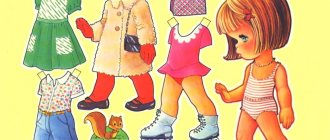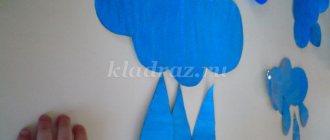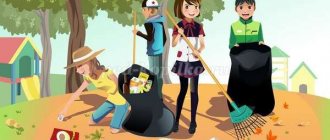Summary of the didactic game on FEMP “Let's help the squirrel”
Summary of the didactic game on FEMP
in the middle group “Let’s help the squirrel”
Target:
learn to count to 5 (based on visualization), using the correct counting techniques: name the numerals in order.
Game objectives:
Educational:
– Form spatial representations: below, above;
– Fix the ordinal count within five;
– To develop the ability to compare unequal groups of objects: 4 and 5.
Educational:
– Develop the ability to compare by size;
– Develop thinking, fine motor skills, attention.
Educational:
– Cultivate interest in mathematics;
– To develop the ability to formulate an answer grammatically correctly;
Progress of the game:
Organizing time.
Educator
: Children! Look who came to visit us! (Squirrel)
Educator
: Let's say hello to the squirrel and ask what's in her basket? (Nuts).
Educator
: Children, Squirrel told me that she was bringing nuts for her
little squirrels, but doesn’t know if there will be enough nuts for everyone. The squirrel can't count, let's help her, guys? (Yes).
Educator:
Then we go into the forest to the baby squirrels and count them. Children go out onto the mat, there are leaves and dry twigs on it.
Educator:
Guys, look how beautiful it is in the forest, what beautiful leaves lie on the ground. Now Squirrel will lead us to her house, and we will follow her very carefully, stepping over the branches so as not to fall.
2
.
Physical exercise “Hello forest”
Hello forest, beautiful forest ( Spread your arms wide to the sides
)
Full of fairy tales and miracles! ( Turns left and right with arms outstretched
)
What are you making noise about?
On a dark, stormy night. ( Hands raised up. Rocking left and right
)
Who is hiding in your wilderness?
What kind of animal?
What bird? ( Children peer into the distance, holding a rounded palm above their eyebrows, while turning to the right and left
.)
Open everything, don’t hide it. ( Spread your arms wide to the sides. Shake your finger
)
You see - we are ours ( Raise your arms up, and then press your palms to your chest.
)
Educator:
Look, guys, we've reached Squirrel's house. Let's move the branches aside and look at the baby squirrels. (Children look at the baby squirrels).
Educator:
What small, fluffy squirrels, let's pet them. (Children take turns stroking). Have you ironed everything? (Yes).
Educator:
Guys, have you forgotten why we came to the forest? (Count the baby squirrels).
3. Fun counting.
Educator:
That's right, let's sit on the chairs and count. Look how I count the baby squirrels: one baby squirrel, two baby squirrels, three baby squirrels, four baby squirrels, five baby squirrels. Natasha, come closer and count the baby squirrels. (One two three four five). Well done!
Summary of the organization and management of a didactic game with children of the middle group
Author: Vyrodova Alexandra Nikolaevna
Didactic game (board-printed)
"Baskets with vegetables and fruits"
Didactic task:
- develop the ability to distinguish vegetables, fruits, berries
- find and name vegetables, fruits, berries
- choose baskets according to what is in them (large vegetables, in the largest basket, smaller fruits, in the medium one, berries in the smallest basket)
Game task:
-choose the right vegetables, fruits, berries, put them in baskets of the right size
Game rules:
Procedure:
- select all vegetables, fruits, berries,
- select the right basket for them
Materials and manuals:
3 baskets of different sizes, 7-9 vegetables, fruits, berries each according to the size of the baskets, 2 envelopes.
Progress of the game:
Surprise moment:
- Guys, yesterday I received a letter from Dunno (show the envelope containing the materials for the game), he asked to give this envelope to the children of the middle group of the Rodnichok kindergarten.
-You don’t know who this is?...
- Well, if it's you, then I delivered the letter correctly.
— In his letter, Dunno writes that he is kidnapped and that only you can free him if you correctly follow the rules of this game.
- Let's quickly see what kind of game Dunno sent us.
(I open the envelope and take out materials for the game)
- Guys, look what an interesting game! And here are the rules of the game (I give the children the opportunity to look at the game material)
(I say the rules at the beginning of the game)
— To save Dunno, you need to choose all the vegetables, fruits and berries correctly. Then you need to choose the right basket for them and put them in the baskets. But you must remember that vegetables are the largest, so they need the largest basket, and berries are the smallest, so they need the smallest basket.
- So, let's start collecting vegetables, fruits and berries, putting them in baskets in order to free Dunno as soon as possible.
(Children collect vegetables, fruits, berries in 3 baskets, the teacher prompts if necessary).
- That's it guys, all the baskets are collected, now we will put them back in the envelope and send them to Dunno so that he can be freed. (I put the baskets in an envelope, take the envelope away, and immediately return with another envelope).
- Guys, I received a second letter from Dunno, in which he thanks you for helping him free himself.
He praises you for your intelligence, for your ability to distinguish between vegetables, fruits, and berries, and promises that guests will soon come to you and play with you. comments powered by HyperComments
Summary of a didactic game for younger preschoolers (3-4 years old)
Didactic game about animals for children of the younger group of kindergarten
Didactic game with elements of conversation about wild animals “Guess the riddle”
Author: Yulia Alekseevna Gorchakova, teacher at the Irdanovsky kindergarten “Kolosok”, Nikolsky district, Vologda region. Description of material: This game is designed for children of primary preschool age, and can also be useful for teachers, educators and parents who want to teach their kids to solve riddles. Goal: learning to solve riddles about wild animals using illustrations of them. Objectives: - continue to introduce children to wild animals of their native land (hare, wolf, bear, fox, squirrel, hedgehog); — teach children to identify and name the distinctive features of wild animals; - stimulate the cognitive interest of children, promote the development of memory, attention, and intelligence; — to cultivate a humane and caring attitude and love for animals. Equipment: illustrations depicting wild animals. Introduction: We, parents and teachers, are often surprised that a child cannot answer a simple question and finds it difficult to guess the simplest riddles. You should not rush to tell your child the answer. It is much more useful if the child independently understands the content and meaning of the riddle and learns to relate some object to the content. If parents quickly offer their child their answer, he will simply lose interest in the game. In solving riddles, the most important thing is to look for the answer; it is the search that teaches the child to think and compare. Teachers and psychologists suggest that we begin learning to solve riddles from the age of three. We, educators, suggest parents start with the simplest thing: with simple questions (“Where are the bunny’s ears?”, “What does the cat say?” and so on). These questions can be asked starting from a very young age. From the age of 2, you can use rhyming riddles in games, where the answer just begs to be answered. Let these be riddles that draw the child’s attention to simple, well-known objects: toys, animals, food, household items. Try to choose riddles that name color, shape, size, habits. To help your child, prepare illustrations for viewing, among which the child will see the answer. Progress of the game: - Guys, look what we have on the table? (Children approach the table on which the pictures are laid out.)
- That's right, these are pictures.
Who is depicted on them? (Wolf, fox, bear, squirrel, hare, hedgehog).
- How can you call them in one word?
(These are animals. Wild animals).
- Let's play with these pictures?
I will ask you a riddle, and you will show me the answer - a picture. Agreed? Listen carefully to the first riddle. 1. “A ball of fluff, Long ear, Jumps deftly, Loves carrots.” Who is this? That's right, bunny. (Show picture).
How did you guess?
(Children name the signs by which they recognized the animal). Looking at an illustration of a hare. - What kind of fur coat does the bunny have? (Soft, white, fluffy, warm).
— In winter the bunny is white, and in summer it is gray.
-Where does the hare live? (Under a bush).
-What does he like to eat?
(Grass, bark, carrots, cabbage).
- How can you affectionately call a hare?
(Bunny, bunny, bunny).
2. At night he howls in the forest: “I’ll carry the lamb away!”
The angry, hungry gray one also knows a lot about hares... (Wolf)
Who is this?
This is a wolf. (Show picture).
How did you guess?
Looking at an illustration of a wolf.
- What kind of fur coat does he have? (Gray, thick).
-What does a wolf eat?
(Catches mice, birds, hares).
— What is the name of his house?
(Lair)
- How can you affectionately call a wolf?
(Little wolf, little wolf, little wolf).
3. He sleeps in a den in winter, quietly snores, and when he wakes up, well, roar, what is his name?
- … (Bear)
Looking at an illustration of a bear. - What kind of fur coat does the bear have? (Thick, warm, brown).
— What is the name of the bear's house?
(Den).
—What does a bear eat?
(Eats berries, honey, sweet roots, fish)
- What does a bear do in winter?
(Sleeping).
- And why?
(In winter there is no food for him; it is difficult for him to walk through the snowdrifts).
- How can you affectionately call a bear?
(Teddy bear, little bear, little bear).
4.Jumps from branch to branch, but rarely comes down to the ground.
The small, fragile body always wears a fur coat. The claws on the paws are sharp: It’s not easy to run up the trunk! This red-haired one flies through the branches like an arrow... (Squirrel)
This is a squirrel.
(Show picture).
Looking at an illustration of a squirrel. -What is she like, little squirrel? (Red-haired, fluffy, agile)
-Where does the squirrel live?
(In a hollow, on a tree).
— What does a squirrel eat?
(Berries, mushrooms, cone seeds, nuts).
- What is a gentle name for a squirrel?
(Squirrel, little squirrel).
5. Guess another riddle.
Red-haired cheat, cunning head. The fluffy tail is beauty, and her name is... (fox).
Look how it is - It’s all burning like gold.
He walks around in an expensive fur coat, his tail is fluffy and large. Looking at an illustration of a fox. -What is she like? (Red-haired, fluffy, cunning).
- Where does he live, what does he eat?
(Lives in a hole, eats mice, birds, bunnies).
- What is a gentle name for a fox?
(Fox, little fox, little fox).
6. He runs along a forest path, carries a mushroom home on his back.
If you don't stroke it, you won't take it. Did you guess it? This is... (Hedgehog)
- That's right, this is a hedgehog.
Looking at an illustration of a hedgehog. - What is he like, a hedgehog? (Small, prickly).
— What does a hedgehog eat?
(Insects, bugs, midges, sometimes fruits and mushrooms. They say that the hedgehog loves to eat apples, in fact, he cleans his needles from parasites with sour apple juice).
— What does a hedgehog do in winter?
(Sleeping).
- What can you affectionately call a hedgehog?
(Hedgehog, hedgehog). Reflection.
— Who did we solve riddles about today? (About wild animals).
— What animals live in the forest?
— Did you like our game with pictures? You are so smart, you solved all the riddles! Which riddle did you like best? What animal? Parents are given creative homework: draw the wild animal that the child remembers most after the game. Result: creative project - exhibition “Wild Animals”.
We recommend watching:
Didactic game for the younger group of kindergarten Didactic game for children 3-4 years old “Vegetable garden” Do-it-yourself didactic manual for kindergarten Do-it-yourself didactic game for the younger group “Gather beads on a string”
Similar articles:
Didactic game for children of the second junior group
Didactic game for the younger group of kindergarten “Colorful dishes”






